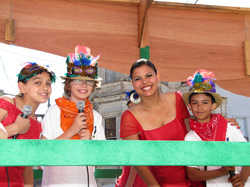|
Approximately 1 billion people around the world are learning English, according to EnglishEnglish.com. Join the ranks of thousands of teachers who are sharing their knowledge of this global language by earning your English as a second language certification. CELTA
The CELTA (Certificate in Teaching English to Speakers of Other Languages) is one of the most widely-recognized certifications. It is accepted by most employers around the world, and it is administered by Cambridge University. CELTA training centers are located in several places, and certification is only available on-site, and it is not available through distance or online education. The DELTA is a certification offered by Cambridge to teachers of English who want to pursue more advanced study of the topic. Online/Conferences Online English as a second language certification programs allow students the flexibility to learn from home and on their own time. The price tag is manageable for most students as well: usually around $300. Talk to other English teachers who pursued their certification online. There is no one accreditation body for any English as a second language certification program. This is especially true for online education providers. Find out from other teachers what their experiences with specific companies were. Look for companies who have good communication with students and with those that offer video trainings to allow teachers to connect what they read about teaching with a classroom. Conferences that take place over a few days are another option for pursuing your English teaching certification. You will get a chance to practice your teaching skills once or twice, get feedback from other students and teachers, and earn your certification in a short amount of time. Conference trainings take place around the country throughout the year. Many companies that offer online training courses also offer conference trainings. Take at least a 40-hour training for any type of certification you pursue. This is the minimum many overseas employers will accept. A 100-hour or more course is preferable. Certifications from Colleges Community colleges and universities often offer certification courses as well. These are often a semester to a year in length, and they are more in-depth than other types of certification courses. Certifications from colleges are often more accepted at adult English as a second language programs in the United States than other types of certifications. Master's degree programs are also available for those who want to learn more of the theory behind teaching English as a second language. These programs usually take about two years to complete, and you will likely need a Bachelor's degree to enroll in such as Master's course. References and Resources CELTA TESOL Directory of Degree and Certificate Programs EnglishEnglish ESL Teachers Board: Discussion Forum Dave's ESL Cafe: General Discussion Forum
1 Comment
 An online English tutor "meets" students from around the world. An online English tutor "meets" students from around the world. What does multicultural education mean, anyway? This is something that I'm learning about as a teacher. I thought it was mostly about sharing information about different cultures of students in the classroom and throughout the world. I'm coming to find out that it is so much more than that. I'm not too sure of all of the ins and outs of it, but it seems to me that multicultural education focuses on making education equal and open for all students. Students also learn about oppression and disrespect, about the contributions of all cultures to the country and the world. They take it a step further and maybe write letters to a store that only carries dolls of the dominant ethnicity in society. Multicultural education does affirm and respect people from all walks of life, but it goes beyond this. It looks long and hard at society and the reasons it is why it is. It tries to change this one person at a time. It begins with the teacher examining his or her cultural values and thoughts about other cultures and perhaps making changes to how the teacher interacts with students, their parents, other teachers and others in their communities. Then it may move to students as they observe his or her model. I imagine my understanding of this idea will develop more and perhaps even change significantly, but these are my first impressions of this new and interesting idea. It's been around for a while, but I'm just now getting around to it.  What's wrong with the sign on this box? What's the plural form of "box"? Hints: Look at "pair's," and the plural of "box" is not "boxs." What's wrong with the sign on this box? What's the plural form of "box"? Hints: Look at "pair's," and the plural of "box" is not "boxs." First of all, let's be VERY clear: THERE ARE NO RULES WITHOUT EXCEPTIONS WHEN IT COMES TO PLURALS IN ENGLISH. Some plural forms of nouns you just have to learn by heart (memorize). HOWEVER: here are some basic rules to help you learn how to form plurals for most nouns. 1.) Most of time, just add s. flowers 2.) Add es if the word ends in o. potatoes 3.) Add es if the word ends in ch, sh, x, z, or s. glasses, churches, boxes, flushes 4.) Add s if the word ends in y with a vowel before it. monkeys, stays 5.) Add ies if the word ends in y with a consonant before it. parties Master these five before you try the next three. These rules are not used very often. 6.) Add s if a proper noun (a name) ends in y. the McKinley family -- the McKinleys 7.) Add s to the main noun in a compound noun, which has more than one word. brothers-in-law 8.) Add s to the end of the end of compound noun with no main noun. follow-ups, trade-ins Source: Painless Grammar by Rebecca Elliott, Ph.D., 1997 Two of my favorite websites for advanced learners to improve their English include Voice of America's Special English and the BBC's Learning English. These sites not only include current news articles, but they also have interactive vocabulary and grammar exercises for you to practice your English based on articles you read. Find the links to them below.
BBC Learning English Voice of America's Special English What other sites have you found that are helpful? Comment below to share the sites with other English students. The good and bad of teaching English online.
Help your students give better presentations with these ideas.
|
AuthorLeyla Norman Archives
July 2020
Categories
All
|

 RSS Feed
RSS Feed
